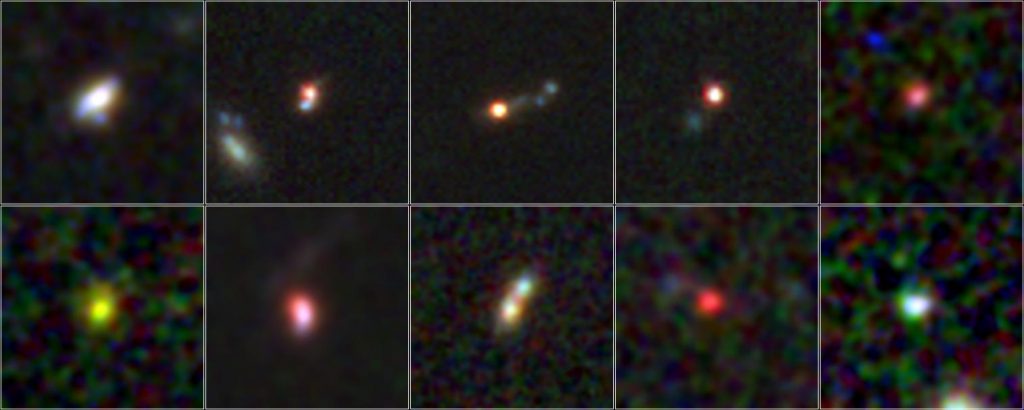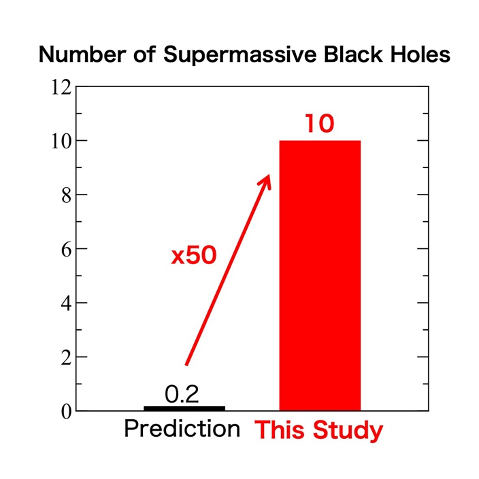James Webb Space Telescope Discovery
Clicking on each image will open the full resolution one. Try it!Clicking on "Raw images" image will yield all the relevant raw images.
JWST discovered numerous supermassive black holes in the distant universe
The research team led by Yuichi Harikane (Assistant Professor at the Institute for Cosmic Ray Research, the University of Tokyo) discovered ten supermassive black holes in the distant universe dating back 12 to 13 billion years by using the observational data obtained by the James Webb Space Telescope (Figure 1). This number is 50 times greater than the predictions based on the previous studies, indicating the existence of a large number of supermassive black holes in the distant universe just 1 to 2 billion years after the Big Bang.
In our universe, there exist supermassive black holes weighing from a million to ten billion times the mass of the Sun. While these black holes reside at the centers of galaxies, when and how they formed remains a fundamental question in astronomy. As a result, the supermassive black holes in the early (distant) universe are of significant interest to astronomers. Traditional exploration of these supermassive black holes involves searching for “quasars,” which shine brightly as black holes consume surrounding matter. Surveys conducted using ground-based telescopes like the Subaru Telescope have discovered numerous quasars in the distant universe 12 to 13 billion years ago. However, compared to the number of galaxies existing in the same epoch, quasars are extremely rare, accounting for less than one-thousandth, and are recognized as rare populations in the distant universe.
The full operation commencement of the James Webb Space Telescope in 2022 enabled us to conduct observations in the distant universe with a sensitivity 10 to 1000 times greater than previous telescopes. This advancement allowed for detailed examinations of the properties of distant galaxies. During analyses of observational data of distant galaxies obtained with the near-infrared spectrometer NIRSpec on the James Webb Space Telescope, Yuichi Harikane and colleagues discovered distinctive broad hydrogen emission lines indicating the presence of active supermassive black holes in 10 galaxies existing in the universe 12 to 13 billion years ago (see Figure 2).
This number of ten black holes was a surprising discovery for the research team, being 50 times greater than what was anticipated based on previous studies using quasars (see Figure 3). Yuichi Harikane, who led the team, expresses the astonishment at that time of the discovery, saying, “I was really surprised when I discovered the broad hydrogen emission lines indicating the presence of supermassive black holes. Based on previous studies, we didn’t expect to find such a supermassive black hole within the limited sky area observed with the James Webb Space Telescope. Initially, I thought it might be some sort of mistake, but the sensitivity of the James Webb Space Telescope was so exceptional, and the broad hydrogen emission lines were so distinctly visible that I became convinced this was genuine.” Harikane continues, “The reason for the existence of such a large number of active supermassive black holes in the distant universe is still unknown, but we believe this would provide clues to understanding the formation of these supermassive black holes in the early universe.”
When looking at the image of the discovered supermassive black hole (Figure 1), it reveals not only small and compact light believed to originate from the supermassive black hole itself but also extended light from the galaxy that harbors this supermassive black hole. The colors vary widely, with galaxies appearing yellowish and others displaying a bluish-white hue. Additionally, there are objects that look small and red, which researchers sometimes refer to as “Little Red Dots.” Yechi Zhang (a graduate student at the University of Tokyo at the time of paper submission), who was involved in analyzing the images, says, “Thanks to the great sensitivity and resolution of the James Webb Space Telescope, we’ve successfully detected not just the light from the supermassive black hole but also the light from the galaxies hosting them. The various colors and shapes seen in the images might indicate the ubiquitous presence of active supermassive black holes in various types of distant galaxies.”
The research team further estimated the masses of these supermassive black holes from spectral information. Kimihiko Nakajima (Assistant Professor at the National Astronomical Observatory of Japan), in the team, explained, “The supermassive black holes we discovered have masses ranging from one million to 100 million times that of the Sun, which is about 100 times lighter compared to black holes associated with quasars. This suggests that they are objects closer to the early stages of formation. Conversely, when compared to similar galaxies in the current universe, the supermassive black holes in these galaxies from the distant universe are about 10 to 100 times more massive, hinting at the possibility of witnessing rapid growth of black holes in the early universe.”
Harikane remarks, “I was originally an astronomer studying galaxies, and I never imagined doing a research related to the black hole until I witnessed the hydrogen emission lines indicating the presence of supermassive black holes. The James Webb Space Telescope, a new eye for humanity, has brought us thrilling unexpected discoveries.” This research will be published in the December 5th, 2023, issue of The Astrophysical Journal as Yuichi Harikane, et al., “A JWST/NIRSpec First Census of Broad-Line AGNs at z=4-7: Detection of 10 Faint AGNs with MBH~10^6-10^8 Msun and Their Host Galaxy Properties”.
Credit: The University of Tokyo
 Fig 1: Pseudo-color image of the ten supermassive black holes discovered by the research team, dating back 12 to 13 billion years, created by combining three-color observational data obtained from either the James Webb Space Telescope or the Hubble Space Telescope. (Credit: NASA, ESA, CSA, Harikane et al.)
Fig 1: Pseudo-color image of the ten supermassive black holes discovered by the research team, dating back 12 to 13 billion years, created by combining three-color observational data obtained from either the James Webb Space Telescope or the Hubble Space Telescope. (Credit: NASA, ESA, CSA, Harikane et al.)
 Fig 2: An example of the observed spectrum of the discovered supermassive black hole. The broad hydrogen emission line highlighted in the red shaded region indicates the presence of an active supermassive black hole. (Credit: Harikane et al.)
Fig 2: An example of the observed spectrum of the discovered supermassive black hole. The broad hydrogen emission line highlighted in the red shaded region indicates the presence of an active supermassive black hole. (Credit: Harikane et al.)
 Fig 3: Number of supermassive black holes discovered in this study (in red) compared to the expectation based on past quasar observations (in black). Since the the James Webb Space Telescope can only observe a limited sky area due to its narrower field of view compared to telescopes like the Subaru Telescope, it was previously believed that rare objects like supermassive black holes would not be found. (Credit: Harikane et al.)
Fig 3: Number of supermassive black holes discovered in this study (in red) compared to the expectation based on past quasar observations (in black). Since the the James Webb Space Telescope can only observe a limited sky area due to its narrower field of view compared to telescopes like the Subaru Telescope, it was previously believed that rare objects like supermassive black holes would not be found. (Credit: Harikane et al.)